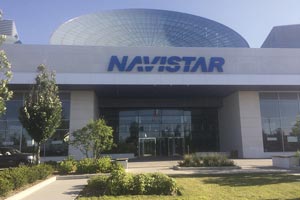Navistar Sets Used-Truck Plan to Lift Appeal of Late Models

This story appears in the Aug. 4 print edition of Transport Topics.
LISLE, Ill. — Navistar Inc. announced the launch of a program aimed at increasing the appeal of its later-model used trucks with exhaust gas recirculation engines.
“Diamond Renewed” includes a vehicle reconditioning, warranty and Navistar’s OnCommand Connection remote diagnostics system.
“We want to give the used-truck buyer the ‘new-truck experience’ that more sophisticated, larger carriers enjoy,” said David Gerrard, senior vice president of distribution, during a July 24 briefing at the manufacturer’s headquarters here.
PHOTO GALLERY: Images from Navistar headquarters
Gerrard said Diamond Renewed will provide fleets a reliable option for lower-mileage used trucks that cost about $50,000 less than new models.
ACT Research on July 25 reported a more than 15% increase in used-truck sales in June from a year earlier, which also was 10% higher than May. It said the average selling price for all used models was $47,345.
“June’s performance was a little counterintuitive, given that sales usually slow in the summer months,” said Steve Tam, an ACT vice president. “While one month does not make a trend, it is a confirmation that demand in the used-truck market remains strong.”
ACT estimates its survey include 10% of the used-truck market.
Navistar said Diamond Re-newed covers 2010 or newer International ProStar, TranStar and LoneStar models powered by the company’s MaxxForce engines with fewer than 400,000 miles.
After Navistar’s MaxxForce EGR engines failed to meet 2010 federal emissions regulations without the aid of previously earned credits, the company switched to selective catalytic reduction. Navistar said every engine in the Diamond Renewed program has received calibration software updates, cleaned or new diesel particulate filters and diesel oxidation catalysts.
The overall inspection process includes more than 180 vehicle and engine points. Also included is a two-year, 200,000-mile warranty.
“These trucks run well when we do the things we are supposed to do,” said Bill Kozek, president of North American Truck and Parts.
Navistar said the Diamond Re-newed process was developed at its used-equipment reconditioning center in Indianapolis, which opened in July 2013. Vehicles in the Diamond Renewed program receive a special decal applied near the doors.
As part of the Diamond Renewed program, the company released a mobile app for its OnCommand Connection remote diagnostics system. The app will be particularly helpful to small fleets and owner-operators who may not be heavily invested in technology, Navistar said.
Other fixes or improvements to the 11- and 13-liter MaxxForce engines involve turbo air control valves, the high-pressure fuel pump and the exhaust process, said Tim Shick, vice president of North American engine sales.
Shick said that despite the engines’ previously well-publicized difficulties, there is a sizable market of truckers that wants the fuel economy the MaxxForce can offer, without the need for diesel exhaust fluid required with SCR engines.
Gerrard said some higher-horsepower engines will be de-rated to 450 hp or less to further improve performance.
ACT President Kenny Veith declined to comment on the Diamond Renewed program, but said “generally truckers are nondenominational beyond pocketbook issues,” when it comes to used trucks.
He said despite “some antidotal negative comments” about EGR engines designed to meet 2007 emission regulations, they are commanding about $8,000 more than 2004 models, when compared with the same life cycle points. That figure is about equal to the higher price when the 2007s were new, showing that “any negative reputation is not being borne out in prices being paid.”
During his overview of the used-truck market, Gerrard said Navistar’s sales have been strong in Western states, due in large part to recent California Air Resources Board regulations that have required some older trucks to be retired.
One region he pointed to for future growth was the Southeast, where port drayage activity is projected to surge as the Panama Canal expansion is completed.
Besides a need for more trucks, the types of used models in greatest demand could shift with distribution patterns.
As an example, Kozek said cargo coming through the canal that arrives at the port of Savannah, Georgia, could then head to Atlanta before moving farther into the U.S. interior.
That would allow drayage carriers to use a day cab — rather than a more expensive sleeper unit — since a driver can make the round trip in one shift and get home at night.

